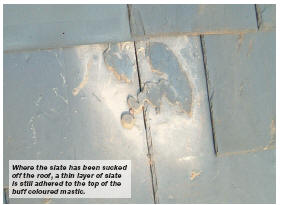 |
 |
 |
 |
 |
 |
 |
|
Check out our web directory of the UK
roofing and cladding industry
www.roofinfo.co.uk |
Sign up for our monthly news letter. |
|
|
|

The supply and use of mastic is one of
the great growth sectors of the pitched roofing industry. There are so
many manufacturers selling a wide range of tube and bead mastics and
sealants, there must be a lot of money to be made. But which should be
used with slates, and where, and why?
Perhaps the safest answer is that a good roof
should be constructed using no mastics at all. We managed to construct
roofs perfectly well before they were introduced, so why are they used?
Convenience is the answer. There is nothing that
so universally fixes anything that is broken than mastic. But is that a
good thing? Like anything that is good, it can be abused and used for
the wrong purpose.
Natural slate
If I look at a slate roof and see slate that is out of alignment, or has
a nail pushed in under the leading edge, it is almost certain that that
slate is held in with some form of mastic. If you need to replace a
slate in a roof, it can be a big job to strip down from the ridge and
replace the slate properly.
Copper tingles will allow a temporary repair of an isolated
slate but are clearly visible from the ground; a thing no roofer wishes
to admit to with a new roof.
Remedial repair clips, like Owen’s Jenny Twins,
are effective and hidden, but not easy to obtain at short notice, and
require some practise to install correctly. So mastic it is!
Unfortunately, with natural slates there is one
big problem with any form of mastic: regardless of how well the mastic
or sealant sticks and bonds to slate, being a laminar stone, slate is
made up of layers of sediment bonded together by heat and pressure; this
is what makes it possible to split it into thin sections. But,
unfortunately, the mastic is only bonding with the outer-most layer of
the material, and if you pull on the bond, the outer layer of the slates
pulls away, leaving the mastic with a thin sliver of slate on the
surface.
Fibre cement slate
But, I hear you say, what about fibre cement slates and resin slates
that are not laminar stone? The act of applying the mastic to the
surface of either the front or back of a double-lap fibre cement slate
is likely to alter the capillary line of water sucked up between the
slates when it rains.
Having a surface that a meniscus of water can
adhere to, it will creep further under the slate than normal. The common
s-shaped squiggle or central blob of mastic gives the water a route to
reach the nail holes, or the top of the headlap, where it drains down
the nail holes or over the headlap onto the underlay, and worse still,
can be trapped in a pocket and freeze, blowing the two slates apart.
Single lap resin slate
With single-lap resin slates, one manufacturer sells a repair kit that
uses PIB (polybutileisolene) bead strips (which is the material that car
windscreens are glued in with) to glue the new tile back into position.
What makes this work is that resin is a known quantity
once the surface silicone release agent has been cleaned off, and the
instructions that come with the material point to where the material
should be adhered to allow the slates to keep water out at all times. If
used incorrectly, the water-shedding properties are affected.
Site conditions
Many mastic materials work perfectly well between certain temperatures,
levels of humidity, onto clean dust and oil-free surfaces. |
 |
|
But, unfortunately, building sites and roofs
are not ideal places to apply some materials. Invariably it will be
raining, or has just stopped raining; the temperature of the roof will
be ice cold or hot enough to fry an egg; and the slates covered with
dust, dirt, diesel fumes and hand prints: not an ideal environment to
apply any mastic. Life
expectancy
Regardless of the type of mastic/sealant, be it silicone, polysulphide,
synthetic resin, polybutileisolene, or any other material, its life
expectancy will never be as good as the slates or lead flashings that
they are trying to adhere to.
Also, the bond strength of the material may be
excellent when it is first applied, but after a few years it will begin
to lose its properties and shrink, crack, discolour, harden and weaken;
but not all at the same time. Some materials will do these things
quicker than others, and generally, the more expensive the material, the
longer it will last; but nothing lasts for ever.
Noise
There are some very good reasons to use mastic on a slate roof. The
first is where some of the slates are a little gappy and rattle in the
wind. By placing a small dob of clear silicone mastic under the two
outside corners of the slate, it acts as a shock absorber and stops the
slate rattling.
Flashings
The second situation is the fixing of lead flashings into a brick joint.
Lead expands and contracts more than most materials and can cause mortar
pointing to break up.
The use of the lead pointing sealant will cope
with the situation far better than mortar. But the material is not
designed to glue lead flashings to slates in place of lead clips. It is
not designed to fill splits in lead both old and new, and it is not
designed to repair broken slates.
Water seal
The third situation is where an end ridge tile is screw-fixed to the
roof structure and the screw and screw-hole need protecting. Filling the
nail hole with silicone mastic and covering the screw head to form a
water proof dome is acceptable, provided you do not want to dismantle it
in the near future.
In conclusion
Like all good things, mastic and sealants should be used sparingly, at
the right time, and in the right place, and they will enhance a good
slate roof; but if not used correctly, can spoil a perfectly good roof.
Tips
- Think twice before using any form of
mastic.
- Read the instructions and conditions
of use data sheet before using the material, to ensure that it
applies to your situation. If it is not listed, do not assume it
will work because it is not listed as not working.
- Never use mastic to glue natural
slates together.
- Never use mastic in very hot or very
cold temperatures.
|
| Compiled
by Chris Thomas, The Tiled Roofing Consultancy, 2 Ridlands Grove,
Limpsfield Chart, Oxted, Surrey, RH8 0ST, tel 01883 724774 |
|